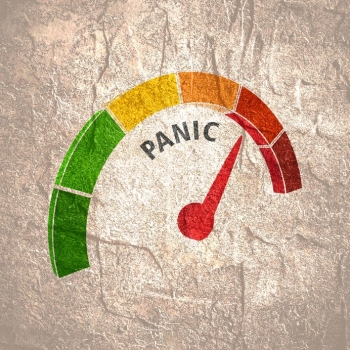
Many people with anxiety can describe exactly what a panic attack feels like. Your heart feels like it’s racing a million beats per minute, you can’t get enough air, you get sweaty or nauseated. You know you would do whatever it takes to avoid having a panic attack. But many people have trouble accurately identifying the warning signs of a panic attack early enough to prevent the panic attack from happening. The following 10 minute exercise, developed by therapists in Center City can help you do exactly that.
Create an Anxiety Scale
Take a piece of 8.5”x11” paper and draw a line down the middle vertically. Put a “10” at the top of the line and a “1” at the bottom, then fill in the rest of the numbers so that you have a scale from 1-10 in the middle of your paper. Label the left side of the paper “memories”, and the right side “symptoms”
Memories
Think about the worst panic attack you’ve ever had. In the memory column next to number 10, write a brief descriptor. For example “panic attack in 2015, at mom’s house, when we were supposed to go to church.” Just enough information to remind you about the memory.
Then go all the way down to number 1. Think about one of the most calming memories you have. Write a brief descriptor of where and when you were, and what was happening.
Go back to number 5. Using your Number 10 and Number 1 memories as anchors, think about a specific time where you felt about halfway between your worst panic attack and your calmest moment. Write a brief descriptor of where and when you were, and what was happening.
Do this for the rest of the numbers on your anxiety scale.
Symptoms
Following the same order as you filled in your memories, write down as many physical symptoms as you can remember for each number. Focus on your heart; your breath’ muscle tension especially in your hands, neck and shoulders; nausea or bowel movements; body temperature; your ability to focus and the speed of your thoughts; any repetitive movements or activities (ring twisting, pacing, foot jiggling, etc); changes in appetite; changes in vision; and any feelings that pop up or change in their intensity. Many people, for example, find that irritation or anger can be present during or immediately prior to a panic attack.
Use as much detail as you can while filling out symptoms for each spot on your anxiety scale.
Pinpoint
Pinpoint the following locations on your scale. Note them with a star or other symbol.
- The point of no return: Looking at the symptoms you listed, what number is usually “the point of no return”? I.e. once you hit this level of anxiety, it’s almost inevitable that you will have a panic attack?
- The “tune-in” moment: At which point on the scale do you typically notice that you’re feeling anxious? What symptoms allow you to do so? Is it a particular noticeable symptom, or the fact that they co-occur with other? How close is this to “the point of no return?”
- The “tune-out” section: Circle everything below the “Tune In” moment. What makes anxiety difficult to notice at this point? What do these symptoms have in common? What masks them?
Put the Anxiety Scale to Use
Set an alarm on your watch or phone to ring at 5 intervals throughout the day. When the reminder goes off, check in with your body. Close your eyes and do a quick scan from head to toe for Anxiety Scale symptoms. Then, take a note (i.e “4pm Tuesday, Level 5, xyz symptoms present.”) Keep a record of these checkins for two weeks. Being able to notice anxious feelings before you reach the point of no return is key to managing panic attacks. By “tuning in” to yourself frequently, you will build your ability to notice your anxiety well before the “point of no return.”
Go Deeper
Look back through your 2 week “tune in” log and look for patterns. How does your anxiety shift throughout the day? What contexts heighten it? Where can you create time to manage your anxiety?
Remember that it’s likely you’ll experience another panic attack at some point in your life- no matter how well we take care of ourselves, we can’t control for all variables. Remember too that having a panic attack, while unpleasant, is not the end of the world. You can’t die from having a panic attack, even if it feels that way sometimes. The Anxiety Scale is meant to help you manage and prevent panic attacks to increase your quality of life and decrease the impact they have on your job, school or relationships.
If you have trouble putting the Anxiety Scale to use, or would like additional help managing your anxiety and panic, make an appointment with a therapist in Center City today. If you live outside Center City, we do offer telephone counseling.















